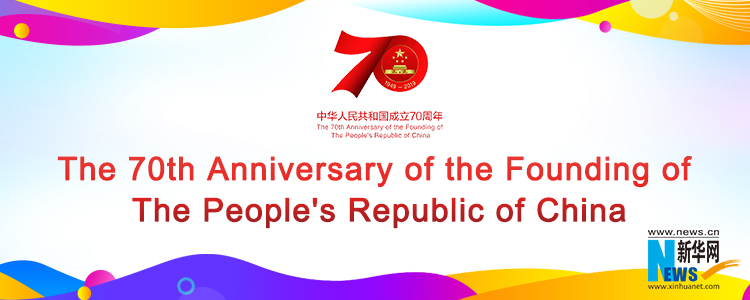BEIJING, Oct. 6 (Xinhua) -- Its vast territory, abundant resources and the world's largest population have brought China numerous opportunities. But for an economy of such size, how to bridge the development gap among different regions is always a challenge.
The past 70 years have witnessed the country's stunning economic achievements, many of which were accomplished through coordinated regional development.
Through meticulously planned regional growth strategies, China has made the country's development more balanced and people's lives better.
J FOR JOINT GROWTH
The country initiated a key strategy in 2014 to coordinate the development of Beijing, its neighboring port city Tianjin and Hebei Province -- a regional city cluster called "Jing-jin-ji."
A prominent task of the "Jing-jin-ji" strategy is to move non-capital functions out of Beijing to treat urban ills such as traffic jams and pollution in the Chinese capital.
In the past five years, 2,648 manufacturing enterprises, 581 markets and 106 logistic centers in Beijing have been relocated, according to the National Bureau of Statistics (NBS).
During the period, the per capita disposable income of residents in Beijing, Tianjin and Hebei registered an annual growth rate of 8.8 percent, 8.2 percent and 8.9 percent, respectively.
As a further boost to the development of Hebei, the country announced the establishment of the Xiongan New Area in 2017, which lies about 100 km southwest of Beijing and spans three counties in Hebei.
Billed as China's "city of the future," Xiongan has been designed to become a zone for innovation, a digital city synchronized with a brick-and-mortar counterpart, and a livable and business-friendly area.
EXAMPLE OF GREEN DEVELOPMENT
While the Beijing-Tianjin-Hebei coordinated development strategy offered the world a way to treat urban ills, the building of the Yangtze River Economic Belt set an example for green development.
Spanning 11 provincial-level regions in China, the Yangtze River Economic Belt covers roughly one-fifth of China's land and contributes more than 40 percent of the country's GDP.
In 2016, China released a development plan of the economic belt that emphasized the priority of ecological conservation and green development.
According to the NBS, 77.2 percent of surface water sections in the Yangtze River Economic Belt were of good quality in the first nine months of 2018, up 10.2 percentage points from 2015.
The ecological improvement came along with economic growth, driven by environmentally friendly industries that are increasingly critical for the country's future development.
A new type of urbanization is also powering the growth of the economic belt. Of all the 248 pilot areas for new urbanization across the country, 81 are located in the Yangtze River Economic Belt.
ROLE MODEL OF HIGH-QUALITY DEVELOPMENT
In October 2018, the 55-km-long Hong Kong-Zhuhai-Macao Bridge was opened to traffic, slashing the travel time between Hong Kong and Zhuhai from three hours to 45 minutes, further integrating the cities in the Pearl River Delta.
The bridge, facilitating exchanges of people, economy and trade among the three areas, is a model project of the Guangdong-Hong Kong-Macao Greater Bay Area.
China in February issued the Outline Development Plan for the Greater Bay Area, aiming to develop the region into "a role model of high-quality development."
Technological innovation serves as a major driving force for the bay area. As of 2018, six Hong Kong colleges had founded 72 scientific research institutions in Shenzhen, while Guangdong and Hong Kong had jointly subsidized 151 innovative programs.
NARROWING REGIONAL GAP
Compared with China's eastern coastal areas, the country's western and northeastern regions are less prosperous, with less advanced infrastructure and more traditional industries.
In a bid to bolster broader growth, Chinese authorities have carried out various targeted development strategies.
After China put forward the West Development Strategy in 1999, the country's western regions have achieved remarkable progress.
Since 2012, the western regions have sustained an average annual GDP growth rate of 8.9 percent, 1.8 percentage points higher than the national growth rate, suggesting an ever-shrinking development gap between the country's east and west.
NBS data showed that 41.7 million people in the western region had been lifted out of poverty since 2012, with the poverty headcount ratio in rural areas falling from 17.6 percent to 3.2 percent in 2018.
New guidelines on advancing western development in the new era are set to be released soon, which will focus more on environmental protection and implementation of the Belt and Road Initiative, reported the China Securities Journal.
Efforts have been made to vitalize the country's northeast region, an old industrial base that relies largely on heavy and chemical industries, energy resources, raw materials and a large number of state-owned enterprises.
The central government has rolled out measures pushing for efficient administration and industrial shifts aimed at helping the rust belt regain its former glory.
Foreign trade has also been robust in the region. In 2018, the volume of imports and exports in northeastern regions reached 179.2 billion U.S. dollars, increasing 3.1 times from 2013, representing an annual growth rate of 10.8 percent.
To further boost the vitality of the western and northeastern regions, China has been encouraging foreign investment, with a new catalog of advantageous industries released to guide investment into the areas.

